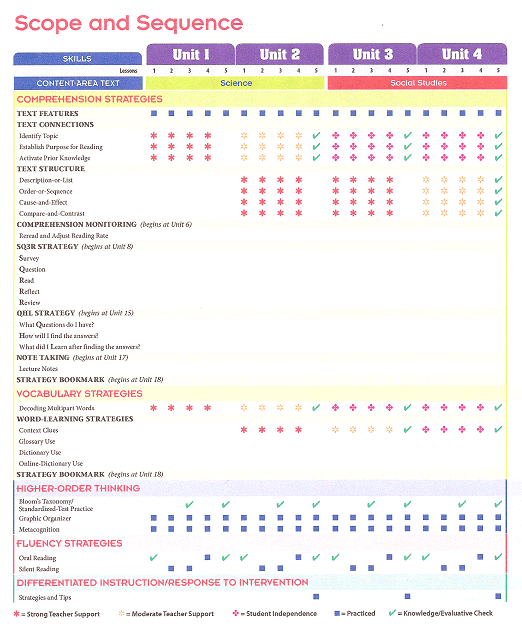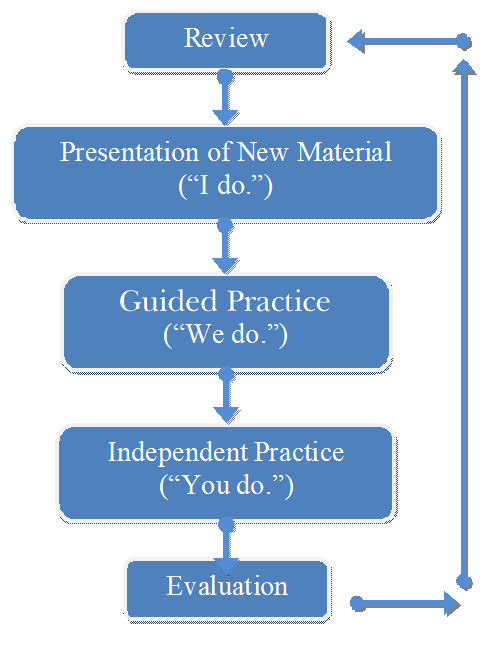Program Design
When we look at how reading curricula or programs are designed, we must examine six curricular variables. These variables include:
- Specify Objectives
- Devise Strategies
- Develop Teaching Procedures
- Select Examples
- Sequence Skills
- Provide Practice & Review
Specify Objectives
An effective reading program includes specific observable behaviors that students will exhibit at various points across the academic year. For example, saying a student will learn to appreciate literature by the end of first grade is not specific or observable. Saying that a student will be reading first grade materials at a certain rate per minute with a certain level of accuracy and comprehension, is more specific and is indeed directly observable (we can take data on this to show that our student met this goal).
To get a handle on objectives, we should examine the scope and sequence of the program. A scope and sequence outlines the various skills and concepts that students will learn in a program across the school year (and across school years in the case of basal programs described later). You can find a scope and sequence in the teacher's guide or manual of most programs. Figure 2.1 shows a sample scope and sequence (Marchand-Martella & Martella, 2010). There are two main types of programs that utilize scope and sequences. These include strand- and spiral-based programs.

Devise Strategies
An effective program includes, whenever possible, strategies to help students learn rather than relying on memorization of isolated facts. Strategies teach a small set of examples and promote generalization to other examples not specifically taught. We liken this to getting a "big bang for our buck." If strategies are not used, we are less assured that students can tackle novel examples. For example, in a sight-word approach, if you teach 10 words you know 10 words. This would not be illustrative of a strategy. If, however, you teach 10 sounds and the skill of blending the sounds together to form a word, students can read 720 three-sound words (e.g., man), 4,320 four-sound words (e.g., slam), and 21,600 five-sound words (e.g., scram) (Becker, 1971). Further, once we have taught 40 sounds, we have the basis for reading a large percentage of the English language. Therefore, we should focus on teaching students in an explicit manner (many programs have precise directions for teachers to follow) to promote generalization via the use of strategies.
Develop Teaching Procedures
Teaching Formats: Once strategies have been identified, they should be articulated into teaching formats. Formats provide specific details for teachers on what to say or do with students, what students should say or do, and other helpful features (e.g., error corrections, praise statements, extension activities, and review procedures). The more explicit the instructions, the easier it will be for teachers to ensure program integrity and consistency. Some programs do not provide these explicit formats for teachers to follow, opening them up for interpretation (or misinterpretation). Statements such as, "I am using this program but it just doesn't work" or "I don't know what to do when my students are struggling with the information I am presenting" or saying to a fellow teacher, "We seem to be running this program in two different ways" could be alleviated if specific formats for instructional delivery (or remediation) were provided for teachers to follow. Detailed formats allow teachers to focus on what is most important--student performance--rather than curricular design and analysis.
A sample format might be set up like this: "Today you are going to learn a new sound.” (Write m on the board.) “This sound is /m/. Say the sound with me, everyone. /m/.” Students say /m/. “Now it's your turn. Say the sound.” Students say /m/. “Yes. That sound is /m/." An error correction might also be placed on the page so teachers can refer to it if needed. For example, "That sound is /m/. Say it with me. /m/. Say the sound by yourselves."
Effective Teaching Sequence: In addition to these well-articulated and explicit formats, an effective curriculum/program should follow an effective teaching sequence. An effective teaching sequence is shown in Figure 2.2. The sequence typically includes the following steps: (a) review, (b) presentation of new information, (c) guided practice, (d) independent practice, and (e) evaluation.

Select Examples
Once teaching procedures including effective teaching sequences and the stages of learning have been developed, examples should be selected. Examples have to do with what is actually presented during the lesson to promote skill acquisition. During the presentation of new information ("I do"), an effective reading program should carefully sequence the examples it provides to students. If curricular examples are not sequenced correctly, students may fail to discriminate appropriately (e.g., saying /b/ for both b and d). Take for instance the introduction of sounds. If we teach letter-sound correspondence in alphabetic order (i.e., /a/, /b/, /c/, /d/, /e/, /f/, /g/...) we may notice that /b/, /d/, and /g/ as well as /a/ and /e/ are highly similar both in how they look and how they sound. If we do not separate these letter-sounds we may actually promote letter reversals, increased mistakes, and student confusion. A better sequence, for example, might be to teach the following: /a/, /m/, /s/, /e/, /r/, /d/, /f/, /i/, /th/, /t/, /n/, /c/, /o/... etc. This sequence separates highly similar letter-sounds, providing a means for students to be more successful and less likely to confuse examples and make mistakes.
During guided practice, these examples should be practiced along with examples from lessons taught previously. In this way, an effective program provides numerous opportunities for students to practice the task at hand and to review what has been taught. This type of practice also helps promote discrimination between and among examples, solidifying students' skills for acquisition, leading later to skill proficiency. For example, if /a/ and /m/ have been taught previously and /s/ is to be taught in the lesson of the day, we should also find practice with /a/ and /m/ during guided practice with /s/.
Sequence Skills
Once examples have been carefully selected, an effective reading program sequences its skills (strategies) to promote student success and to reduce student errors. Five sequencing guidelines should be followed when sequencing skills (strategies) to teach something such as reading (Carnine, Silbert, Kame’enui, & Tarver, 2012).
- Pre-skills of a strategy are taught before the strategy itself is presented.
- Instances that are consistent with the strategy are introduced before exceptions.
- High utility skills are introduced before less useful ones.
- Easy skills are taught before more difficult ones.
- Strategies and information likely to be confused are not introduced at the same time.
We can examine a program's scope and sequence to determine if sequencing guidelines are followed. For example, if a program targets the teaching of blending sounds together to form words, an important preskill would be acquisition of the sounds to be blended. Thus, when we focus on blending the sounds in am the students should already know the individual sounds of /a/ and /m/. We may also peruse the curriculum to see the sequencing of skills (strategies). For example, we may see the hard /c/ sound taught in words such as cake, car, candy, and cat. However, we would not see the soft /c/ sound as in face, pace, trace, etc. taught at the same time because this would be an exception to what is being taught, namely that this letter says the sound /c/ (i.e., hard /c/ sound).
This example leads into the issue of high utility skills being taught before less useful ones. More words in the English language have the hard /c/ sound as in cake and are thus higher utility skills (occur more frequently than words with the soft /c/ sound). Again, it does not mean that we won't teach the soft /c/ sound--we just want to ensure that students have learned the hard /c/ sound before introducing an exception.
Easy skills taught before more difficult skills speak to the issue of behavioral momentum. Behavioral momentum means that students are more likely to tackle tougher skills if they can build on the success of previously taught (and easier) skills. An easy skill might be to sound out two (e.g., me, am) and three sound words (e.g., man, sat) before four (e.g., fish) and five sound words are introduced (e.g., slams).
Provide Practice & Review
The final consideration when viewing program design is to examine practice and review opportunities provided to students. An effective reading program provides numerous opportunities for students to practice what they have learned. We may even view the number of activities as so frequent that it seems "boring" to us; however, naive learners need multiple opportunities to practice a skill over time. In this way, the practice and review opportunities are not about us -- they are about the students. The students are just as excited to practice a sound again and to achieve success as the last time you presented it.
With practice comes the notion of "perfect practice make perfect" rather than "practice makes perfect." What we mean here is that students should be provided numerous opportunities to practice the skill over time in a successful manner. Remember, we need to increase academic learning time (ALT). An effective program can promote increased ALT in the classroom. In addition, practice opportunities should be "massed" and "distributed" over time. If we teach a skill once, some students will probably "get it," but many more will not. If we practice it a few more times, more students will get it, but others will not. If we provide repeated opportunities over time for students to practice the skill (i.e., massed practice) followed by distributed practice where students practice the skill over time (e.g., on a less frequent but consistent basis), we will promote maintenance of the skill over time.